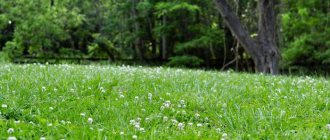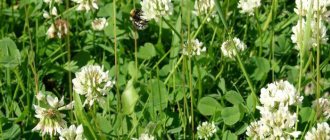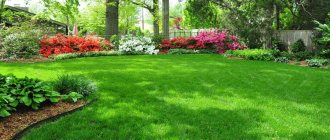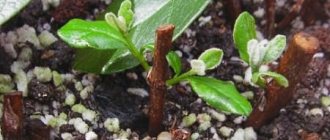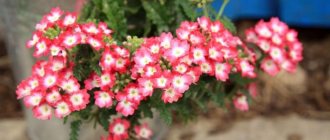Editor Lawn and Soil 40305
A clover lawn is a godsend for large areas. In places where yesterday weeds were rampant and bare earth looked inhospitably, a soft, lush carpet will bloom. Many gardeners, when talking about clover, prefer to replace the concept of lawn with lawn or meadow.
The perennial grass belongs to the legume family. It looks very cute thanks to the small pompom flowers against the background of emerald patterned leaves. In the stage of an adult developed plant, it quickly spreads and covers the entire available area. More than 300 varieties are known. For home plantings, choose one low-growing species.
The second name is trefoil. This definition in Latin means the presence of three leaves. Finding four leaves was considered a happy omen. However, varieties have now been bred in which all leaves are quadruple. The main purpose of the crop is food for herbivores. Contains a lot of nutrients. It is grown and harvested in agriculture.
Characteristics
This is a common low-growing plant with creeping stems and branching roots. The branch has three leaves with white streaks. Belongs to the legume family. Since spring, the earth is covered with an elegant bright green carpet. In summer, white flowers appear, which are inflorescences of many small tubular flowers.
During flowering, clover is covered with white fluffy inflorescences Source dary-prirody.su
An unpretentious meadow plant grows throughout Russia. The branched roots go to a depth of 250 cm. The basal system contains buds, which protects the bush from being eaten by animals. Thanks to the activity of bacteria that absorb nitrogen, small tubers appear on the roots. This is the result of a natural symbiosis, as a result of which the plant receives nitrogen from the air and processes it into an easily digestible form.
The perennial is unpretentious to the soil - it grows well both on fertile black soil and on aluminous soil. It does not require frequent watering, it spreads on the surface as a continuous carpet, without forming bald spots, unlike lawn grass.
It blooms twice a year, but blooms for the first time in the second year after sowing the seeds. The first series of flowering occurs from May to August, the second - from August to October.
Sowing
The best time is the end of summer. The plant will take root and grow well before frost. The soil is completely cleared of weeds. Fertilizers are applied as necessary. Then it is carefully compacted. Seeds are scattered like lawn grass. Embedded in the soil up to three centimeters.
If it is possible to calculate, sowing should be carried out during the rainy season. Watering is required daily, so a natural option will reduce costs and effort.
Combination with other plants
On the ground, the shamrock behaves aggressively. He is an invader of new territories. If you plan to combine its sowing with other plants, then you need to stimulate their growth with mineral fertilizers.
Looks great under bushes and trees. When planting different varieties in a flower garden, it is better to isolate them with a small border.
Varieties of white clover
Botanists have developed a large number of plant varieties: Volat, Pipolina, Klondike, Dukhmyany, Ronnie, Sylvester, Rivendell. With such an abundance of varieties, you have to decide which clover to choose for your lawn in order to spend less time on care.
A decorative variety of microclover creates a continuous green carpet Source sadrium.ru
Decorative microclover is gaining popularity thanks to:
- drought resistance;
- elegant evergreen cover;
- strong roots that ensure high growth - there are almost no bald spots, as they quickly overgrow.
Why is white clover good for the lawn?
"White porridge" is widely used in landscape design. The planting quickly forms a fluffy emerald carpet decorating the area. The lawn is pleasing to the eye, suitable for relaxation, and children can frolic on it. Planting is used for:
- designing borders and circles around trees;
- sowing the space between the beds and paths in the garden;
- sowing between stone slabs;
- creating lawns;
- lawns.
Edging a garden path Source lifegazon.ru
See also: Catalog of companies that specialize in landscape design
Next, let's take a closer look at the pros and cons of a clover lawn:
Positive sides
The culture is popular among gardeners due to the following advantages:
- decorative – planting creates a bright green flooring, enlivened by white color during flowering;
- pleasant soft surface - it’s pleasant to walk on the green carpet without shoes;
- does not require frequent watering, tolerates dry periods well;
- resistance to trampling;
- does not require fertilizers, as it is a soil-improving crop. After harvesting, you can grow vegetables;
- not afraid of frost;
- cut grass can be used as animal feed;
- flowers serve as a source of nectar for bees;
- a dense root system prevents the growth of weeds;
- fixes the soil;
- inexpensive price;
- perennial crop - no need to plant it every year, just add seeds to the soil once and maintain the appearance by mowing and watering;
- grows on any soil;
- quickly restores appearance after mowing;
- universal – suitable for creating both large and small lawns;
- good compatibility with rock gardens, fountains, rose gardens, and various flower beds.
Bees flock to flowers Source lifehelper.one
Flaws
Lawn clover has some disadvantages:
- the need to remove dead inflorescences to give an aesthetic appearance, since after flowering the lawn looks unattractive;
- Care should be taken when walking after watering or rain, as wet turf slips;
- the attractiveness of flowers to bees can be a disadvantage for those with small children;
- rapid growth can cause crowding out of garden crops, so it is necessary to fence the plantings;
- immediately after mowing, the lawn does not look aesthetically pleasing;
- timely trimming is required, as large grass breeds slugs and snails;
- tubers attract various pests, for example, click beetles, so you should not arrange a lawn near garden crops.
When creating a lawn from white clover, the pros and cons must be taken into account so as not to be disappointed with the result.
Description of the plant
Clover is a widespread plant in the middle zone. Two types of clover are used in cultivation: red and white. Both can be useful to a gardener: the first makes an excellent green manure, and the second makes a beautiful flowering lawn.
White clover has been used for lawns for a relatively long time. This application is quite obvious - in nature, clover is a creeping plant that covers the ground with thick greenery. Clover is very hardy and can withstand trampling. It grows very quickly, covering bald spots on the site, and hides uneven landscapes well. Creeping clover is resistant to frost, fungus, and pests.
Clover is useful not only from an aesthetic, but also from an agrotechnical point of view. Its roots accumulate natural nitrogen, and as a result, the soil on the site becomes more fertile. The root system of clover is very deep - the length of the roots reaches 50 cm. Thanks to this property, clover is able to strengthen slopes and decorate even sandy soils. If your site has sandy bluffs and uneven spots, clover is great for hiding them.
Reproduction
Clover "White Porridge" is propagated in two ways: seeds and shoots. The seeds are easy to collect yourself:
- To do this, large faded inflorescences are picked;
- select seeds from the husk;
- laid out in one layer and dried in a dry place protected from the sun.
The dried seeds are placed in a cloth bag or paper bag.
You can collect clover seeds yourself Source nuttygrass.files.wordpress.com
Making a lawn out of white clover
An unpretentious, fast-growing plant ideal for landscaping. It is enough to plant the seeds once and you will enjoy your lawn for many years. Seeds are planted in late winter so that they do not have time to swell and sprout. They will overwinter in the soil and germinate in the spring. You should take into account the fact that almost half of the seedlings will die, so take twice as much seed material.
You can plant at the end of August - the seeds will have time to germinate and take root before the onset of cold weather.
Spring planting is preferred, including several methods:
- ordinary - seeds are placed in prepared grooves in the soil to a depth of 1.5 cm and watered;
- on the ice crust - the method consists of scattering grains on the snow floor. After the snow melts, they will fall into the ground and germinate;
- seeds mixed with sand are scattered on the ground. By the light spots you can find out where the seed material ended up.
Stores sell seeds ready for planting. After reading the instructions, you can easily plant. One hundred square meters will require from 2.5 kg to 3.0 kg of seeds.
Seeds are sold in packaging, with sowing instructions on the label Source cdn1.ozone.ru
The crop is sown in April-May, when the temperature rises to +10-13 degrees. To prevent your lawn from causing problems with abundantly overgrown weeds, treat the area with a herbicide. Work begins with digging up the soil. Next, you need to clear the area of weed roots, compact the soil with a roller and level the surface.
The plant does not grow well in acidic soil. In this case, it is necessary to add dolomite flour or lime to the ground. Seeds can be planted using one of the above methods. Mix the seed with sand and spread evenly over the moistened area. Cover the top with a layer of peat and soil. It is not recommended to plant deeply - up to 1 cm on light soils, up to 0.5 cm on heavy soils.
The crops must be watered abundantly. It is better to do this using a hose with a sprinkler so as not to wash away the top layer of soil. The first shoots will appear in a week. Increased watering leads to the appearance of fungal diseases.
You can renew your lawn every five years by sowing seeds.
Delivery of orders in Moscow and Russia
"Russia Green" delivers orders throughout the city of Moscow and the Moscow region. Delivery times depend on the total weight of the purchase. We deliver parcels weighing up to 20 kilograms in one day, and parcels weighing more than 20 kilograms – within three days.
Shipping costs depend on your location and total order weight. If it is necessary to deliver goods within the Moscow Ring Road, the price will be:
- Up to 5 kg - 250 rubles.
- From 5 to 20 kg - 350 rubles.
- More than 20 kg - 500 rubles.
If delivery outside the Moscow Ring Road is required, its cost directly depends on the transportation distance:
- From 0 to 5 km – 750 rubles.
- From 5 to 10 km – 1250 rubles.
- From 10 to 25 km – 2000 rubles (important condition: order amount – not less than 5000 rubles).
- From 25 to 50 km – 3000 rubles (important condition: order amount – not less than 5000 rubles).
The delivery service hours on the Moscow Ring Road are from 10 a.m. to 9 p.m. on weekdays, on Saturdays from 10 a.m. to 6 p.m.
Delivery of goods to other cities of Russia is carried out:
- If the weight is less than 40 kg - by courier service.
- If the weight is more than 40 kg - by transport company.
- If the order weighs less than 9 kg, we can send the goods by Russian Post.
Proper care is the key to a beautiful lawn
The lawn does not require special care, but it looks better if you water it once a week and mow it after flowering. In dry weather, watering is increased more often. If you have not treated the area with herbicides, you will have to remove the weeds by hand.
A haircut
Tall plant thickets encourage the appearance of slugs and snails. Therefore, after flowering, a haircut is required.
Mowing with a lawnmower Source fermer.blog
A lawn with clover will acquire an aesthetic appearance, and flowering will increase. Destroying flowers prevents the development of seeds and the growth of the crop. In the first year, the planting is not cut. The next year after planting, when the plant grows, it will require pruning.
Fertilizer
Before planting, humus is added to the soil. Potassium-phosphorus fertilizing is done once every two months. To give a better look, skinny plants are sprayed with boron fertilizers.
Answers on questions
The question often arises about at what time to aerate the lawn. Gardeners say that it is advisable to carry it out in late spring. After the first shoots, you will see what the lawn looks like: voids and thickening. The place where aeration is needed will immediately become noticeable.
One of the frequently asked questions is: “What type of clover should I plant on my lawn?”
Gardeners advise choosing white creeping trefoil. He has many species that are low-growing and hardy. There are even some who don't cut their hair.
Pest Control
With high humidity, the plant is susceptible to infection with fungal diseases: rust, fusarium, ascochyta blight, anthracnose, brown spot. As soon as the first symptoms of the disease appear, the plantings must be sprayed with a 1% solution of colloidal sulfur. After 10 days, the procedure is repeated. You can pollinate with slaked lime or sulfur powder.
The dodder wraps around the stem and feeds on the sap of the plant Source kccc.ru
The nuances of planting clover
Experts on growing clover give advice:
- do not push the seeds too deep into the ground;
- when planting in a dark place, double the number of seeds;
- It is better to plant a clover lawn on the sunny side so that it grows well;
- To prevent the plant from spreading beyond the lawn, surround it with a stone border;
- on overly moist soils, arrange drainage, as clover does not like excessive moisture;
- do not plant in flooded low-lying areas;
- After wintering, plant seeds in the area of bald spots. With small voids, you don’t have to worry, as clover grows quickly.
Biological features
Creeping clover belongs to the genus Clover, legume family, subfamily Moth family. It has a wide range, initially distributed throughout Europe, in Central, Asia Minor and Western Asia, in Transcaucasia and North Africa.
This is a herbaceous perennial plant with a developed, creeping bare stem, compound trifoliate leaves with small elongated leaves and spherical flower heads collected in panicles. Blooms 2 times per season. Clover fruits are orange and yellow-gray legume pods with 3-4 heart-shaped seeds. The seeds ripen from June to July.
Clover grows best in wet, cool climates and prefers loamy, rich soils with good moisture but not stagnant water.
Did you know? Like other legumes, clover enriches the soil with nitrogen, so it is often used as green manure to improve the structure and composition of the soil.
How to remove a landing
If you decide to change your landscape design, or someone is allergic to flowers, then getting rid of the plant is not difficult.
The plant is pulled out by hand Source 7ogorod.ru
You can pull it out by the roots and fertilize the ground with nitrogen fertilizer, which slows down the growth of clover, but has a beneficial effect on other crops.
Another way to remove shamrock is to water the area with ammonium nitrogen. In a month and a half it will disappear.
Beneficial features
Trefoil is endowed with medicinal properties, which is why it is widely used in traditional medicine:
- as a diuretic;
- choleretic;
- antiseptic;
- expectorant;
- hemostatic.
anti-inflammatory;
Many other diseases were treated with the plant: decoctions, tinctures, lotions. Clover lotions help against wounds, burns, and skin diseases.
Decoctions and tinctures treat inflammation in the body, cleanse the blood, relieve swelling, headaches, remove unnecessary fluid.
Delicious and medicinal clover honey. It is aromatic and has a pleasant taste. Thrifty housewives season soup with seasoning made from dried flowers, and cut stems and leaves into vegetable salads, since they are rich in essential oils and vitamins.
Briefly about the main thing
Clover for the lawn is the best option for landscaping the area, which does not require large material and labor costs. By sowing plants once, you get a green area for many years, even if you don’t care for it diligently. If you make an effort, the lawn will become the pride of the landscape. In addition, it is pleasant to lie on it, walk barefoot, and the plants will not be crushed, since the flexible stems restore their shape. Well, the cut grass can be used as animal feed.
The crop has advantages and disadvantages, but there are more positive qualities - the lawn requires almost no maintenance, sowing once, waste can be used as animal feed. Under proper conditions and care, the flower almost never gets sick. And the soil becomes fertile after planting.
You will get a beautiful lawn that changes color as it blooms. It is unlikely that you will not like the planting. It has to be removed in rare cases.
Ratings 0
Reviews
- Vladimir, 56 years old: “My wife and I live in a private house, and the company gave us another large plot of land for a dacha outside the city. In the first years, we simply did not have time to cultivate it, so we immediately decided to plant it with green manure, and then gradually plant different vegetables in its place. The clover grew on its own, formed such a uniform green field, and the neighbors, seeing that we were not doing anything with it, asked to mow it to make hay for their animals. After they mowed it for the fourth time this summer, the clover began to grow poorly, I read that frequent mowing leads to weakening of its roots. Therefore, in the second year, there were only islands of plants on the site, and not a full field, and the unfilled areas had to be replanted.”
- Nikolai, 42 years old: “After buying a house, I decided for myself that on my site there would be complete unity with nature, and this means no digging up the soil, no chemicals and the like. At most I will go through some places with a Fokin flat cutter, to loosen the soil and that’s all. When asked how to saturate it with the necessary natural fertilizers and improve its composition, I chose sowing green manure. I used red clover in this capacity; in the first year I bought seeds of its white counterpart, but then I was tormented in the fall to get rid of it: it spread all over the site, and the roots penetrated deep into the ground.”
